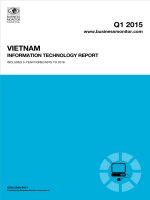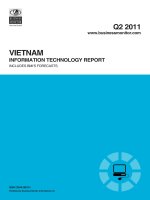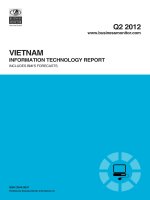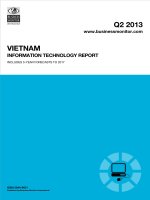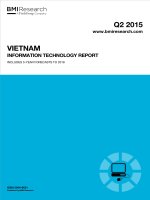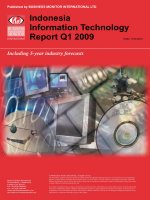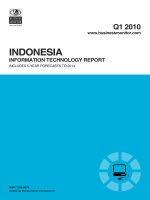Indonesia information technology report q2 2015
Bạn đang xem bản rút gọn của tài liệu. Xem và tải ngay bản đầy đủ của tài liệu tại đây (462.7 KB, 89 trang )
Q2 2015
www.businessmonitor.com
INDONESIA
INFORMATION TECHNOLOGY REPORT
INCLUDES 5-YEAR FORECASTS TO 2019
ISSN 1750-5070
Published by:Business Monitor International
Indonesia Information Technology
Report Q2 2015
INCLUDES 5-YEAR FORECASTS TO 2019
Part of BMI’s Industry Report & Forecasts Series
Published by: Business Monitor International
Copy deadline: January 2015
Business Monitor International
Senator House
85 Queen Victoria Street
London
EC4V 4AB
United Kingdom
Tel: +44 (0) 20 7248 0468
Fax: +44 (0) 20 7248 0467
Email:
Web:
© 2015 Business Monitor International
All rights reserved.
All information contained in this publication is
copyrighted in the name of Business Monitor
International, and as such no part of this
publication may be reproduced, repackaged,
redistributed, resold in whole or in any part, or used
in any form or by any means graphic, electronic or
mechanical, including photocopying, recording,
taping, or by information storage or retrieval, or by
any other means, without the express written consent
of the publisher.
DISCLAIMER
All information contained in this publication has been researched and compiled from sources believed to be accurate and reliable at the time of
publishing. However, in view of the natural scope for human and/or mechanical error, either at source or during production, Business Monitor
International accepts no liability whatsoever for any loss or damage resulting from errors, inaccuracies or omissions affecting any part of the
publication. All information is provided without warranty, and Business Monitor International makes no representation of warranty of any kind as
to the accuracy or completeness of any information hereto contained.
CONTENTS
BMI Industry View 7
SWOT 9
IT 9
Wireline SWOT 11
Political 12
Economic 14
Operational Risk 16
Industry Forecast 18
Table: IT Industry - Historical Data And Forecasts (Indonesia 2012-2019) 18
Macroeconomic Forecasts 25
Economic Analysis 25
Industry Risk Reward Ratings 29
Table: Asia Pacific Risk/Reward Index - Q2 2015 31
Market Overview 32
Hardware 32
Software 41
IT Services 49
Industry Trends And Developments 54
Regulatory Development 59
Table: Key Ministers And Departments 59
Competitive Landscape 63
International Companies 63
Table: Lenovo Indonesia 63
Table: Intel Indonesia Corporation 64
Table: Microsoft Indonesia PT 65
Table: IBM Indonesia 66
Table: Foxconn Technology 67
Local Companies 68
Table: Performance PT Multipolar Technology Tbk (MLPT) 68
Table: Walden Global Services (WGS) 69
Table: Aprisma Indonesia 70
Table: ALTiUS ERP 70
Company Profile 71
Sigma 71
Indonesia Information Technology Report Q2 2015
© Business Monitor International Page 4
Regional Overview 75
Demographic Forecast 79
Table: Population Headline Indicators (Indonesia 1990-2025) 80
Table: Key Population Ratios (Indonesia 1990-2025) 80
Table: Urban/Rural Population And Life Expectancy (Indonesia 1990-2025) 81
Table: Population By Age Group (Indonesia 1990-2025) 81
Table: Population By Age Group % (Indonesia 1990-2025) 82
Methodology 84
Industry Forecast Methodology 84
Sources 85
Risk/Reward Index Methodology 86
Table: It Risk/Reward Index Indicators 87
Table: Weighting Of Components 88
Indonesia Information Technology Report Q2 2015
© Business Monitor International Page 5
BMI Industry View
BMI View: The depreciation of the rupiah against the US dollar was a small drag on IT market growth, but
caused no significant disruption, a state of affairs we expect to be maintained into 2015. We again expect
the drag of rupiah depreciation to be outweighed by the upside from strong economic growth, a low PC
penetration rate, enterprise and public service modernisation and an emerging middle class. As such we
identify retail hardware, enterprise software and cloud computing as medium-term growth opportunities.
However, there is short-to-medium term downside if the Indonesian growth story is derailed by regional or
global economic headwinds. In the short-term, IT spending is forecast to increase to IDR170.2trn in 2015,
up 11.1% from 2014, with the IT market estimated to account for almost 1.5% of GDP.
Headline Expenditure Projections
Computer Hardware Sales: IDR97.0trn in 2015 to IDR132.9trn in 2019, at a compound annual growth
rate (CAGR) of 7.4% in local currency terms. Even after strong growth in recent years, we expect
momentum to be maintained by a deepening of the market as incomes rise and device prices continue to
decline as Android tablet vendors and Microsoft notebook vendors compete aggressively on price.
Software sales: IDR28.2trn in 2015 to almost IDR53.0trn in 2019, at a CAGR of 17.0% in local currency
terms. Piracy is a major drag on software market growth, but new legislation could help reduce the drag
from 2015.
IT Services Sales: IDR45.0trn in 2015 to IDR85.3trn in 2019, at a CAGR of 17.2% in local currency terms.
Improvements in network infrastructure and increased awareness among local enterprises will ensure strong
growth in cloud service adoption, which we expect to be a key demand driver for IT services 2015-2019.
Key Trends & Developments
Piracy has been a drag on the development of the Indonesia software market for many years. The anti-
piracy lobby group estimated Indonesia had the highest incidence of piracy in BMI's APAC coverage at
84% in 2013 - a figure that was unchanged from 2007. In light of slow progress and the scale of the squeeze
on software spending, we welcome the passage of new legislation through Indonesia's House of
Representatives in September 2014, with the bill set to come into law in 2015. The new law is aiming to
increase efficiency and effectiveness of Indonesia's copyright system, particularly its enforcement
mechanisms. The new law has been received well by copyright owners, with the removal of ambiguity
Indonesia Information Technology Report Q2 2015
© Business Monitor International Page 7
evident in previous legislation welcomed. However, we argue that anti-piracy legislation is just the first-step
in combating the problem, with investment in enforcement and education required to act as a deterrent and
shift public opinion in the area of IP protection.
A major new push by the public and private sector in Indonesia to increase the coverage and capacity of
wireless and wireline infrastructure is expected to provide a boost to both hardware demand, as end-users
have new use cases, and to software and services as greater volumes of data, and the potential applications,
are generated. Under the 2014-19 Indonesia Broadband Plan, up to IDR278trn (USD23.2bn) is to be
invested in extending wireline broadband services to 30% of the urban population and 6% of the rural
population, while mobile broadband services are to be rolled out to 52% of rural consumers. Approximately
10% of the ambitious project will be financed by the state, meaning that the onus will fall squarely on
Indonesia's wireline and mobile operators. The most significant actor is incumbent operator PT Telkom
Indonesia, who plans to triple its investment in broadband in 2015 as part of its support for the new
initiative. It will spend IDR45trn (USD3.7bn) installing public Wi-Fi hotspots and backhaul transmission
facilities and augmenting its fibre-optic backbones and satellite footprints in its bid to boost take-up of
converged services.
Indonesia Information Technology Report Q2 2015
© Business Monitor International Page 8
SWOT
IT
SWOT Analysis
Strengths
■
Large potential market with population of almost 250mn at the end of 2013, and
forecast to reach almost 267mn in 2019.
■
The market may be entering a faster growth stage. It is forecast to grow quicker than
most other Association of South East Asian Nations (ASEAN) markets over the
forecast period.
■
Local presence of major global vendors in terms of sales and production, providing
linkages for local start-ups and entrepreneurs.
Weaknesses
■
Underdeveloped telecommunications infrastructure, due to years of government
control and slow progress in deregulation.
■
History of recent political instability.
■
High piracy rate continues to be a drag on the software market, with the highest
piracy rate in the region and slow progress in reducing incidence of unlicensed
software.
■
Indonesia overtook China as the largest source of cyber attack traffic in 2013, with
cyber threats becoming an increasingly important issue for domestic users as well.
Opportunities
■
Investment in telecoms and datacentre infrastructure should lay the foundations for
rapid growth of cloud computing services, with SMEs considering a particularly
attractive target group.
■
New copyright law in 2015 should help reduce incidence of software piracy.
■
Computer ownership is low, but rising incomes and wider internet access will enable
period of rapid 'catch-up growth'.
■
Strong demand for tablets and low-cost laptops from a youthful population and
booming economic performance.
Indonesia Information Technology Report Q2 2015
© Business Monitor International Page 9
SWOT Analysis - Continued
■
IT services, with local telcos investing heavily in data centres, networks, machine-to-
machine communication and cloud computing services.
Threats
■
Continuing lack of government action to support increased PC penetration and
internet access, or drive ICT sector development.
■
Regional economic instability could derail economic growth.
■
Cyber security risks, both from criminals and state actors, could undermine
confidence in networked infrastructure ie cloud computing and IoT.
Indonesia Information Technology Report Q2 2015
© Business Monitor International Page 10
Wireline SWOT
Strengths
■
Fixed-wireless offers a balance between fixed line and mobile at affordable prices and
has experienced strong demand, helping to boost overall fixed-line subscriber figures
in an otherwise slowing market.
■
Increased competition in the fixed-wireless market following the award of nationwide
licences to Bakrie Telecom and Smartfren.
Weaknesses
■
Limited competition in the fixed-line market with Telkom dominating with an 80%-
plus market share.
■
Low teledensity rates, especially in the fixed-line sector.
■
Limited available capital via loans could hinder further progress of the broadband
market.
■
Poor fixed-line infrastructure means limited internet accessibility in rural areas.
Opportunities
■
Plenty of opportunities for broadband growth, with a higher number of operators
awarding contracts to the likes of Nokia Siemens Networks and Ericsson.
■
Submarine cable projects are on the rise, connecting Indonesia to regional peers such
as Hong Kong and then onwards to Singapore and Vietnam.
■
Solid economic outlook led by domestic demand should aid growth of the telecoms
industry.
Threats
■
Uneven development between urban and regional areas could be further
exaggerated, with current broadband contracts centring on the larger islands of Java
and Sumatra.
■
The cost of PCs and tariffs could place internet and broadband services out of the
reach for the majority of Indonesians.
■
Growing preference in the consumer segment for mobile broadband solutions.
Indonesia Information Technology Report Q2 2015
© Business Monitor International Page 11
Political
SWOT Analysis
Strengths
■
Indonesia managed a successful transition to democracy in 2004. In addition, the
2009 parliamentary and presidential elections passed peacefully, signalling the
consolidation of the democratic process. Despite a lengthy challenge by Prabowo
Subianto, 2014's elections also passed peacefully, resulting in the election of Joko
'Jokowi' Widodo.
■
The military's role in politics has gradually been reduced. The prospects of a military
coup - which seemed a real possibility in the late 1990s and early 2000s - have
diminished substantially. As the military's role in politics continues to wane,
Indonesia's political stability should likewise improve.
Weaknesses
■
Indonesia's domestic political scene is characterised by a proliferation of minority
parties and formal and informal coalitions are necessary to govern and legislate.
Moreover, the efficiency of state institutions is encumbered by bureaucracy and
corruption. Prospects for reform are beset with numerous challenges, such as the
long-running practice of politicians promising government positions to campaign
supporters.
■
The country was impacted by separatist rebellion and ethnic violence in the late
1990s and early 2000s, which took great efforts to bring to heel. In the event of a new
economic crisis, calls for regional secession could re-emerge.
Opportunities
■
Indonesia has built a more stable democracy following peaceful handovers of
executive power dating back to the early 2000s. We expect this trend to continue to
bolster political stability over the coming years.
■
Indonesia's status as the world's most populous Muslim country leaves it well
positioned to speak out on global Islamic issues and act as a bridge between the
Middle East and the Asia Pacific region.
Threats
■
Regional militant group Jemaah Islamiah poses a lingering threat to security in
Indonesia. Jemaah Islamiah is blamed for a series of attacks, including the Bali
bombings of October 2002 and the Jakarta bombings of July 2009.
Indonesia Information Technology Report Q2 2015
© Business Monitor International Page 12
SWOT Analysis - Continued
■
The fact that Indonesia subsidises basic goods means that when the government
raises prices, there is a risk of public unrest, or at least a political backlash.
Additionally, Indonesia's population is extremely young, with more than 50% of
Indonesians younger than 30. Younger populations have historically been a predictor
of political instability.
Indonesia Information Technology Report Q2 2015
© Business Monitor International Page 13
Economic
SWOT Analysis
Strengths
■
Indonesia's strategic location between the Indian and Pacific Oceans and its
adjacency to major east-west trade routes make it an important economy in the
region. Indonesia is also resource-rich and is the world's largest producer of palm oil.
■
Indonesia has a low cost and large supply of available labour resources. Its labour
force, the fourth-largest in the world, is also one of the world's youngest.
Weaknesses
■
Indonesia's economy is not growing fast enough to reduce unemployment, with the
rate still relatively high at 5.9% as of Q314. Many are forced to work in the informal
sector. Of particular concern is the youth unemployment rate, which is five times the
overall rate.
■
Indonesia's physical infrastructure is considered sub-standard. The archipelagic
nature of the country makes it difficult to weave national infrastructure together.
Despite an ambitious infrastructure revitalisation plan, the country currently compares
unfavourably with its Association of Southeast Asian Nations peers.
Opportunities
■
Indonesia could attract much-needed foreign investment by strengthening its
business environment, particularly through reform of its unreliable legal system.
■
Indonesia stands to benefit from the rise of Islamic financing, having adopted new
legislation in early 2008 designed to tap into this rapidly expanding sphere. With an
overall market share of only 3%, growth prospects for Islamic banking in the world's
largest Muslim country are enormous.
Threats
■
Production at Indonesia's ageing oil fields has been in decline since the mid-1990s.
The country has therefore become a net importer of crude oil in recent years, putting
downward pressure on its current account position. The resumption of the Cepu field,
which occurred in late 2009, may help to alleviate Indonesia's dependence on foreign
oil given its small boost to production output, but we expect this bounce to be short-
lived.
Indonesia Information Technology Report Q2 2015
© Business Monitor International Page 14
SWOT Analysis - Continued
■
Indonesia is perceived as one of Asia's riskier destinations. This leaves the economy
vulnerable to sudden capital outflows at times of risk aversion, which can lead to
sharp swings in the currency.
Indonesia Information Technology Report Q2 2015
© Business Monitor International Page 15
Operational Risk
SWOT Analysis
Strengths
■
Investors in Indonesia's major cities benefit from a large labour pool.
■
There are some diversification options for supply chains with road and railway
networks on the main island of Java. It is also the location of several airports and the
country's most important seaports.
■
The domestic financial market is well developed, providing opportunities for portfolio
investment, access to credit and links to international finance centres.
■
Indonesia has a lower rate of violent crime than some neighbouring countries.
Weaknesses
■
Low enrolment and attainment levels at secondary and tertiary education levels,
particularly in rural areas.
■
The transport network is severely underdeveloped on most islands of the Indonesian
archipelago, including the large and resource-rich territories of Sumatra, Kalimantan
and Papua.
■
Burdensome trade bureaucracy adds significant delays to the processes of exporting
and importing.
■
Police force corruption is a major issue, meaning many crimes go unreported or
inadequately investigated.
Opportunities
■
The country's universities have a growing international reputation and are attracting
partnerships with foreign universities.
■
Internet usage is becoming more widespread, with businesses already able to take
advantage of easier communication with clients and customers.
■
Tariff and non-tariff trade barriers to trade with the country's neighbours are lowered
due to Indonesia's membership of the Association of South East Asian Nations
(ASEAN) Free Trade Agreement.
Indonesia Information Technology Report Q2 2015
© Business Monitor International Page 16
SWOT Analysis - Continued
■
Membership of ASEAN will continue to foster greater cooperation between South
East Asian countries, improving the response to terrorism and reducing the risk of
interstate conflict.
Threats
■
There is a high risk of workers strikes disrupting business activity.
■
Strong population growth will place further pressure on the struggling education
system.
■
Port congestion will continue to keep lead times for importing goods elevated and
deter international shipping companies from using Indonesian terminals as direct
ports of call.
■
Porous borders, lack of police funding, and costly and slow legal processes mean
that intellectual property (IP) protection is likely to remain lax despite the broad
coverage of IP legislation.
Indonesia Information Technology Report Q2 2015
© Business Monitor International Page 17
Industry Forecast
Table: IT Industry - Historical Data And Forecasts (Indonesia 2012-2019)
2012 2013 2014e 2015f 2016f 2017f 2018f 2019f
IT market
value,
IDRmn
104,241,202 136,390,387 153,180,044 170,213,665 190,809,518 214,088,280 240,635,226 271,195,900
IT market
value, %
of GDP
1 2 2 2 2 2 2 2
Computer
hardware
sales,
IDRmn
64,838,028 83,198,136 90,376,226 97,021,789 104,945,235 113,466,788 122,723,965 132,885,991
Personal
computer
sales,
IDRmn
50,281,890 64,403,677 69,571,619 74,270,180 79,884,313 85,883,012 92,362,056 99,438,587
Software
sales,
IDRmn
15,740,422 20,526,753 24,202,447 28,170,362 33,010,047 38,642,935 45,239,423 53,018,799
Services
sales,
IDRmn
23,662,753 32,665,498 38,601,371 45,021,514 52,854,237 61,978,557 72,671,838 85,291,111
e/f - BMI estimate/forecast. Source: BMI.
BMI extended the forecast for Indonesia's IT market to 2019 in the Q2 2015 update, but our bullish outlook
for the growth of the Indonesian IT market in 2015 and over the medium term is unchanged. We base our
positive medium term outlook on Indonesia's potential for rapid catch-up growth due to low penetration
rates for devices and solutions, combined with our in-house Country Risk team's assessment of economic
trends, as well as declining product and solutions prices across the region. These favourable trends have
attracted significant inward investment, which will add to growth momentum over the forecast period.
Meanwhile we expect strong growth in enterprise demand over the medium term as modernisation
initiatives gather pace and cloud delivery opens software deployments to a wider market by putting
downward pressure on prices.
Our view of Indonesia's potential to be a regional and global outperformer in terms of IT market growth is
unchanged in Q2, with a CAGR of 12.1% forecast 2015-2019, and total sales expected to reach IDR271trn
in 2019.
Indonesia Information Technology Report Q2 2015
© Business Monitor International Page 18
2015 Outlook
BMI forecasts IT market growth of 11.1% in 2015 in Indonesia is unchanged, with total market value still
expected to reach IDR170.2trn. As noted above, the strong economic outlook is fundamental to our IT
market forecast as Indonesian consumers remain optimistic about job, finance and spending prospects. We
forecast real GDP growth of 5.5% in 2015 and 5.0% real private final consumption growth, with both
figures accelerating from 2014. Furthermore we forecast a slowdown in rupiah depreciation against the
dollar in 2015 compared to 2012-2014, although it will remain a drag on growth.
IT Market Growth
(2012-2019)
Indonesia - IT market value, IDRmn
2012 2013 2014e 2015f 2016f 2017f 2018f 2019f
0
100,000,000
200,000,000
300,000,000
e/f - BMI estimate/forecast. Source: BMI.
The largest component of the Indonesian IT demand continues to be for computer hardware sales, but
they are forecast to underperform software and services growth rates in 2015. Nonetheless demand growth
will remain robust as a result of income growth and the relatively low penetration rate - ensuring demand
comes from both first-time buyers and the replacement/upgrade market. Household PC penetration reached
15.1% in Indonesia at the end of 2012 - less than half the APAC average of 31% and below the global
Indonesia Information Technology Report Q2 2015
© Business Monitor International Page 19
emerging market average of 27.6%. This fact, when considered alongside Indonesia's large and growing
population and trajectory of rising incomes, illustrates the growth opportunity in the retail hardware market.
We forecast hardware spending growth will make an important contribution in absolute terms with growth
of 7.4% forecast in local currency terms for 2015.
BMI expects government policy will remain supportive of IT market growth in 2015. Indonesian
development policy is aiming to lift Indonesia into the ranks of the world's top 10 economies by 2025 - a
boon to ICT investment. Direct spending by the government on infrastructure will boost the market in 2015.
Government IT spending is expected to increase and continue to account for around 25% of the IT market,
while the government is also encouraging state companies to use more IT.
Datacentre investment is expected to remain on its strong growth trajectory in 2015, which will open up the
market for cloud computing to a much wider user base in Indonesia. For instance, telecoms incumbent, PT
Telkom Group, expects to be operating the fourth-largest data centre business in the world with 100,000
square metres of capacity by the end of 2015. New tier-2 and tier-3 facilities were scheduled for completion
by YE14 and, with the completion of Indonesia's first tier-4 facility also scheduled for YE14, Telkom
already has an estimated 70,000sq m of capacity at its disposal at the start of 2015. We expect capacity
increases to result in lower Infrastructure-as-a-Service costs, catalysing adoption.
Market Drivers
Income growth trends in Indonesia should provide the foundations for robust growth in retail hardware
demand. Weak income growth among the poorest 20% of the population will be of little consequence to the
IT market, with incomes forecast to reach just IDR10.9mn (USD991) in 2019 - meaning they will remain
outside the device market. However, strong income growth for the middle 60% and richest 20% of the
population - with forecast CAGR of 10.5% and 12.2% respectively 2015-2019 - will broaden the
addressable market.
BMI believes income growth among the richest 20% bodes well for premium devices sales, which should
benefit premium oriented vendors including Apple, while the income growth for the middle 60% of the
population should deepen the market as consumers benefit from increased disposable income and acquire
first household/personal devices.
Indonesia Information Technology Report Q2 2015
© Business Monitor International Page 20
Income Per Capita Breakdown
(2012-2018)
Poorest 20%, net income per capita, IDR
Richest 20%, net income per capita, IDR
Middle 60% of population, net income per capita, IDR
2012 2013e 2014e 2015f 2016f 2017f 2018f
0
25,000,000
50,000,000
75,000,000
100,000,000
e/f - BMI estimate/forecast. Source: BMI, National Statistics Office
A more active approach by the government to encourage IT development, including the establishment of the
National ICT Council, headed by President Yudhoyono, should stimulate spending through a series of
infrastructure and education initiatives. The Indonesian government's Master Plan for Acceleration and
Expansion for Indonesia Economic Development (MPEEI) states that connectivity between the islands of
the country is a priority area. Major government infrastructure and ICT initiatives, particularly the Palapa
Ring Project, have been rolled out to create the infrastructure to support IT market growth.
Two significant government policies were announced in late 2014 with implications for IT market
development. First, Indonesia's House of Representatives passed a draft of Indonesia's new Copyright Bill
in September 2014, which will come into law in 2015. The new law is aiming to increase efficiency and
effectiveness of Indonesia's copyright system, particularly its enforcement mechanisms. The new law has
been received well by copyright owners, with the removal of ambiguity evident in previous legislation
welcomed and potentially a boost to software market spending growth. Meanwhile, Under the 2014-19
Indonesia Broadband Plan, up to IDR278trn (USD23.2bn) is to be invested in extending wireline broadband
services to 30% of the urban population and 6% of the rural population, while mobile broadband services
are to be rolled out to 52% of rural consumers.
Indonesia Information Technology Report Q2 2015
© Business Monitor International Page 21
Another potential demand driver will be organisations looking for help to utilise efficiencies from cloud
computing, such as SaaS and infrastructure-as-a-service. The cloud computing market is currently small in
absolute terms, but as network infrastructure improves alongside increased supply of cloud products, BMI
forecasts bullish medium term growth at a CAGR of 33.4% 2015-2019.
The enterprise market will also boost spending on IT products and services as modernisation initiatives are
undertaken by firms looking to expand into neighbouring markets and/or defend domestic positions. Private
enterprises, particularly SMEs, will provide a large part of PC sales, while ERP and other e-business
applications are also finding increasing popularity in the SME market. The SME sector of 42.2mn
companies will drive demand for basic hardware and applications, as enterprises look to enhance
productivity through automating inventory, accounting and other functions.
Segments
BMI has a bullish outlook for the development of enterprise spending on IT products and solutions
2015-2019 in Indonesia. Due to relatively low levels of PC penetration among Indonesian enterprises,
especially among the large base of SMEs, we expect demand for desktops to be maintained for the duration
of our forecast period. However the consumer market is also expected to remain dynamic and offer
considerable growth opportunities for hardware vendors. Demand for traditional notebooks has been eroded
by the popularity of new form factors in recent years by combination form low-cost tablets, but BMI
expects hybrids/convertibles could gain traction as prices decline over the medium term, with first-time
buyers likely to see multi-functionality as a major positive over tablets not running full versions of
operating systems.
Indonesia Information Technology Report Q2 2015
© Business Monitor International Page 22
Indonesia GVA By Sector (%)
2015f
f = forecast. Source: BMI, National Statistics, World Bank, UN
Turning to enterprise software and services enterprise demand, BMI identifies the large manufacturing,
mining and tourism sectors as potentially fruitful verticals for vendors of enterprise products and solutions.
These are expected to be the largest three contributors to IT market spend in 2015, and there are
modernisation drives underway in all three verticals. Meanwhile, despite cutbacks due to the financial crisis,
the financial services segment will continue to be overweight in enterprise IT spending due to the demands
of the industry. Spending on regulatory compliance and security solutions are expected to register the fastest
growth. The market also remains relatively under-penetrated, with IT implementations largely limited to
transactional support. Islamic banking also presents strong growth opportunities over the next few years.
Additionally, we expect inward investment in manufacturing facilities as wages rise in China to create
demand for enterprise software deployments in Indonesia to connect with global supply chains, as well as
create efficiencies.
BMI believes the healthcare IT opportunity, and other public services, will be a major contributor to growth
over the medium term. As an emerging market with a relative lack of legacy public service delivery
Indonesia Information Technology Report Q2 2015
© Business Monitor International Page 23
infrastructure - and challenging geography combined with the demands of urbanisation - we expect IT
services vendors with innovative solutions could win major contracts in the years to 2018. Telecom
operators are emerging as key players in the smart services segment in Indonesia, with Telkomsel
partnering with Jasper Technologies in late 2014 for a nationwide Internet of Things (IoT) platform, while
Ooredoo, the parent company of local telecoms operator Indosat, stated in January 2015 that it is targeting
the IoT 'Smart City' opportunity in Jakarta.
The SME opportunity is highly significant over the medium term, with government data showing 70% of
the 56.5mn Indonesian SMEs use no IT solutions. IT services for this segment will be dominated by basic
services such as system integration, support systems, training, professional services, and outsourcing. We
expect cloud vendors to be in a strong position to tap this demand, with cloud cost structures favourable for
SMEs versus the economics of on-site deployment.
Local players will capture a share of this growth through to 2019, but the SME market has also attracted the
attention of global leaders, for instance, in October 2014 IBM promoted it SoftLayer IaaS product in
Indonesia to SMEs, offering server, processor, RAM, and storage in the cloud for USD100 per month.
Meanwhile, global software giant Microsoft launched the latest Office 365 SMB software package aimed at
businesses with less than 250 employees. This combination of local and global supply should make the
SME market a hard fought battleground among vendors over the medium term.
Indonesia Information Technology Report Q2 2015
© Business Monitor International Page 24
Macroeconomic Forecasts
Economic Analysis
BMI View: While we believe that Indonesia's real GDP growth is likely to accelerate to 5.5% in 2015 from
an estimated 5.1% in 2014 on the back of improving terms of trade and fiscal efficiency, we note that broad
structural reforms will be necessary in order to return to the 6.0%+ growth rates that the government is
targeting.
The Indonesian economy clocked its slowest rate of expansion since 2009 in Q314, expanding at a rate of
5.0% year-on-year (y-o-y) versus consensus expectations of 5.2%. In expenditure terms, the major drag on
the economy came from the investment category, where gross domestic capital formation growth fell to
3.5% y-o-y from a rate of 4.0% in Q214. As we noted previously (see '2015 Growth Outlook Tempered As
Momentum Continues To Slow', November 17 2014), Bank Indonesia (BI)'s ongoing tight monetary policy
campaign, which began in June 2013 in concert with the government's fuel price hikes, has taken the steam
out of Indonesia's investment boom. That said, it is important to note that the central bank was arguably
behind the curve in tightening its monetary policy stance to begin with, which led to the economy's
overheating leading up to its hikes in 2013.
This overheating assumed the form of rapid credit creation which then fueled both fast investment rates as
well as sprightly consumption growth. Along with a deterioration in the country's terms of trade as a result
of external factors, this led to a rapid decline in Indonesia's current account deficit, and a subsequent loss of
confidence in the rupiah. That said, we believe that the central bank's more hawkish policy under current
governor Agus Martowardojo has now had time to feed through the economy, as evidenced by slowing rates
of growth in both the investment space as well as credit creation. As a result, BI has largely regained its
policy-making credibility by preventing the build-up of any catastrophic asset bubbles in the domestic
economy.
Hawkishness Likely To Fade In H215
Nevertheless, with the central bank's policy rate likely to stay put at least through H115, economic growth is
unlikely to pick up dramatically in the near-term. The government's reduction (and later partial scrapping)
of fuel subsidies has sent headline inflation soaring, reducing room for the central bank to ease policy
despite the economic slowdown. However, as we have written recently (see 'BI To Remain Hawkish
Throughout H115 Despite Slow Growth', January 8 2015), a spate of disinflationary factors (including
slowing money supply and credit growth, along with collapsing oil prices and a smaller fiscal deficit) will
Indonesia Information Technology Report Q2 2015
© Business Monitor International Page 25
